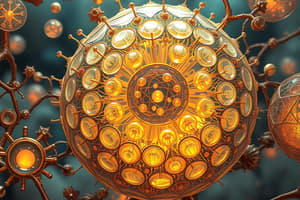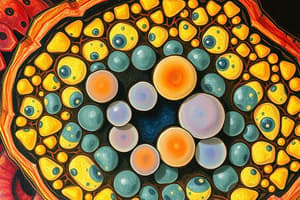Podcast
Questions and Answers
What is the fundamental structural unit of living organisms?
What is the fundamental structural unit of living organisms?
The cell
What is the basic functional unit of life?
What is the basic functional unit of life?
The cell
What are the two main types of cell division?
What are the two main types of cell division?
Mitosis and meiosis
What is the process by which new cells are made?
What is the process by which new cells are made?
What type of cells are formed in mitosis?
What type of cells are formed in mitosis?
Why do specific cells of reproductive organs divide to form gametes?
Why do specific cells of reproductive organs divide to form gametes?
What is the difference in chromosome number between mother cells and daughter cells in meiosis?
What is the difference in chromosome number between mother cells and daughter cells in meiosis?
What is the role of mitosis in organisms?
What is the role of mitosis in organisms?
What is the cell membrane composed of?
What is the cell membrane composed of?
What is the active part of a cell?
What is the active part of a cell?
Flashcards are hidden until you start studying
Study Notes
Division of Labour in Cells
- Cells exhibit division of labour through specialized components known as organelles.
- Each organelle has specific functions like synthesizing materials and removing waste.
- All cells possess the same organelles, regardless of their specific functions or the organism they belong to.
Characteristics of Cells
- Cells are considered the structural and functional units of life due to their ability to carry out essential biological functions.
- Upon examination under a microscope, three fundamental features are consistently observed in all cells: plasma membrane, nucleus, and cytoplasm.
- These features enable cells to perform activities and interact with their surrounding environment.
Plasma Membrane
- The plasma membrane is the outermost layer of the cell, acting as a barrier between the cell's contents and the external environment.
- It regulates the entry and exit of materials, allowing some substances to pass while restricting others.
Cell Variations
- Cells vary in shape and size, with differences depending on their specific functions.
- For instance, cells within the human body include various types such as blood cells, muscle cells, bone cells, nerve cells, ovum, and sperm, each adapted to its unique role.
- Some organisms, like Amoeba, can change shape, while others maintain a fixed shape associated with their function.
Functions of Living Cells
- Living cells perform essential functions that are characteristic of all living forms, such as metabolism, growth, and response to stimuli.
- In multicellular organisms, a division of labour allows different body parts to specialize in distinct functions, enhancing overall efficiency (e.g., heart for pumping blood, stomach for digestion).
Studying That Suits You
Use AI to generate personalized quizzes and flashcards to suit your learning preferences.




